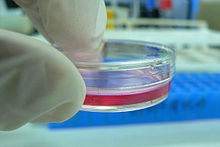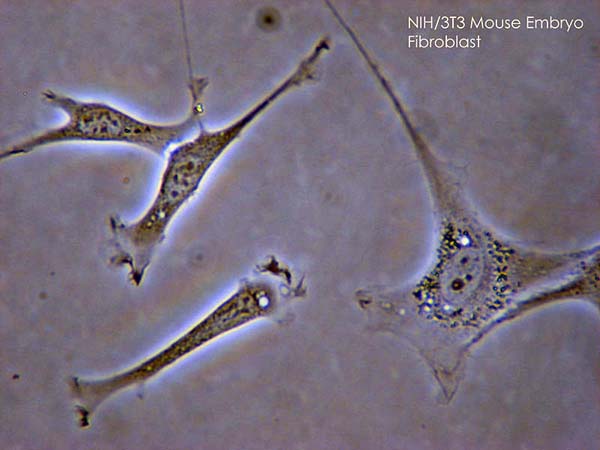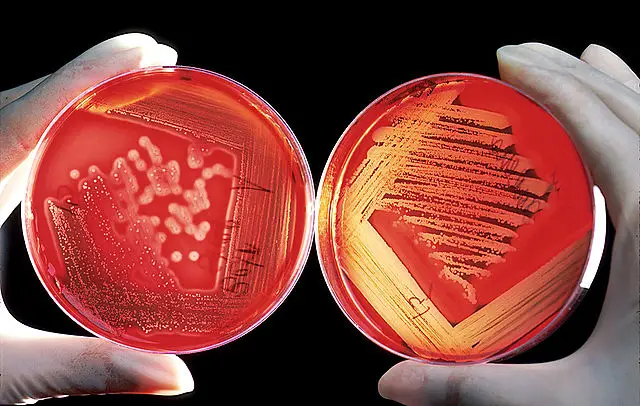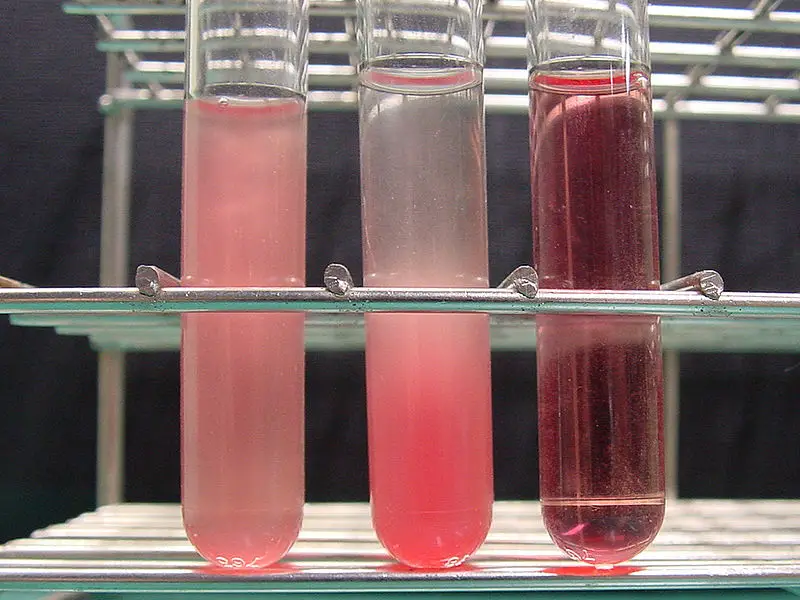Cell Culture
- Basics, Techniques and Media -
Essentially, cell culture involves the distribution of cells in an artificial environment (in vitro) which is composed of the necessary nutrients, ideal temperature, gases, pH and humidity to allow the cells to grow and proliferate.
- In vivo - When the study involves living biological entities within the organism.
- In vitro - When the study is conducted using biological entities (cells, tissue etc) that has been isolated from their natural biological environment. E.g. tissue or cells isolated from the liver or kidney.
Whereas pieces of tissue can be put in the appropriate culture to produce cells that can then be used for culture (explant culture), cells from tissues (soft tissue) can be obtained through enzymatic reactions. Such enzymes as trypsin and proname are used to break down the tissue and release the desired cells.
When cells have been obtained directly from the organism/animal tissue (or even plant tissue) through enzymatic or mechanical techniques, such cells are referred to as primary cells. However, cells that continue to proliferate indefinitely (after the first subculture) under special conditions are referred to as cell lines.
These particular cells tend to have been passaged for a long period of time, which causes them to acquire homogenous (similar) genotypic and phenotypical traits.
Morphology
Based on their appearance, cells in culture can be categorized in to three main groups:
- Fibroblastic - This includes cells that tend to be bipolar/multipolar with elongated shapes. These cells are attached to the substrate as they grow.
- Epithelial - Epithelial like cells attain a polygonal shape with regular dimensions. Although they tend to grow in discrete patches, these cells also grow attached to the substrate.
- Lymphoblast - These cells are usually spherical in shape and do not attach to the surface of the substrate. As a result, they are grown in suspension.
* For solid plates, solidifying agents (such as agar) are used where the liquid media is used with agar.
Significance of Cell Culture
Cell culture is an important technique in both cellular and molecular biology given that it provides the best platform for studying the normal physiology and biochemistry of cells. A cell is the basic structural, functional and biological unit of all living things.
In order to understand an organism or given tissues, it is important to understand how its cells work. Through cell culture, this becomes possible especially due to the fact the primary cells resemble the parental cells from the organism/tissue.
Whatever is learnt about the cells in vitro is representative of what is happening to the organism/tissue. This makes cell culture significantly important for vaccine development, screening (drugs etc) and diagnosis of given diseases/conditions.
Given that different types of cells require different environments for proliferation, there are different types of media used for culture such as serum-free media and serum containing media among others.
Once the right requirements have been provided, the cells will increase in numbers and may form colonies, which can then be easily seen and identified. However, all this requires that the purpose of the procedure be understood.
Having a good understanding of what the procedure is meant to achieve, it becomes easier to prepare the culture with the right components. By understanding what the procedure is aimed for, the researcher will know whether to prepare a selective media (which allow for specific cells to grow) or differential media (allowing for different types of cells to grow).
Primary Cell Culture
Cell culture is a process where cells (animal or plant cells) are removed from the organism and introduced in to an artificial environment with favorable conditions for growth. This allows for researchers to study and learn more about the cells.
There are three major types of cell culture, which include:
- Primary cell culture
- Secondary cell culture, and
- Cell line
Here, we shall focus on primary cell culture.
There are two types of primary cells:
Adherent cells - Also referred to as anchorage dependent cells, these are the type of cells that require attachment for growth. Adherent cells are immobile, and obtained from such organs as kidney.
Suspension cells - These are the type of cells that do not require attachment in order to grow. They are therefore also referred to as anchorage independent cells, and include such cells as lymphocytes found in the blood system.
In primary cell culture, cells obtained from such parental tissues (living tissues) as the liver and kidney, are introduced into suitable media for growth. Once the cells have been obtained, they can either be cultured as explants culture, suspension or monolayer.
* In primary cell culture, the cells must have been obtained from the parental/living tissue. That is, they are not from another culture process.
Before the cells are cultured, they are first subjected to enzymatic treatment for dissociation. However, has to be for a minimal amount of time to avoid damaging or killing the cells. Once single cells are obtained, they are then appropriately cultured in media to allow them to grow (divide) are reach the desired numbers.
Initially, the culture tends to be heterogeneous in that it's composed of different types of cells obtained from the tissue. Although this can be maintained through the in vitro process (in a culture in a suitable media) this would only be for a limited period of time.
Through the transformation process, the primary cells may be used for a long period of time, changing the culture over time. These cells are refers to as continuous cell lines.
However, primary cells are typically preferred over continuous cell lines because of the fact that they are more similar (physiologically) to in vivo cells (cells from the living tissue). In addition, continuous cell lines may undergo certain changes (phenotypic and genotypic changes) which would result in discrepancies during analysis. As such, they cannot be used to determine what is happening to the in vivo cells. It's for this reason that primary cells are preferred.
Given that the primary cells significantly resemble the cells obtained from living tissue, they are important for research purposes in that they can be used to study their functions, metabolic regulations, cell physiology, development, defects and conditions affecting the tissue of interest.
Also, they are used for such purposes as vaccine production, genetic engineering drug screening as well as toxicity testing and prenatal diagnosis among others.
Cell Culture Media
In cell culture techniques, cells (or tissues) are removed from a plant or an animal and introduced into a new, artificial environment that can support their proliferation (survival and growth).
Some of the requirements of such an environment for the proliferation of the cells include:
- A substrate (source of nutrition)
- Ideal temperature range (controlled)
- Growth medium, and
- Ideal pH among others
Here, we shall focus on the medium (cell culture media)
Although there are different types of culture media (for different types of cells) they are typically composed of:
- Glucose
- Amino acids
- Vitamins
- Inorganic salts
- Attachment factors Etc.
There are two major types of culture media. These include:
Natural media - Natural culture media is composed of biological fluids that are naturally occurring. Although this type of media can be used for a range of cells, its biggest disadvantage is that it may lack the exact components required by given cells, which can greatly affect reproducibility.
Artificial media - Also referred to as synthetic media, artificial media refers to the type of media that is produced by adding such nutrients as vitamins, gases (oxygen and carbon dioxide) and protein among others. These organic and inorganic nutrients are added so as to meet the specific needs of given cells, and thus provide the ideal environment for their growth.
As such, they can be used for a number of purposes including:
- Providing immediate survival of the cells
- Allowing for prolonged survival of the cells
- Allowing for indefinite growth of the cells
- Providing for specialized functions
On the other hand, culture may be categorized as:
Selective media- This is a special type of media that only allows for certain cells to grow. For instance, blood agar (used to isolate Streptococcus & Moraxella species) can be turned in to a selective media by adding antibiotics.
Differential media- This type of media allows for different types of cells/microorganisms to grow depending on their metabolism.
As mentioned above, different types of synthetic media are prepared in a manner that will provide the ideal proliferation environment for given cells. For this reason, synthetic media can be divided in to four major categories.
These include:
Serum containing media - In these types of media, serum (fetal bovine serum) is used as a carrier for nutrients and growth factors among others that tend to be water insoluble.
Serum-free media - These types of media is typically produced for the purposes of supporting single cell type of culture. As such, it provides specified nutrients and other factors required by the cell type. In this media, serum is absent because it present some disadvantages and can result in misinterpretation of immunological results.
Chemically defined media - Like the name suggests, this type of media is composed of contamination- free pure organic and inorganic ingredients. Constituents of this type of media are typically produced through genetic engineering in bacteria/yeast.
Protein-free media - Protein- free media are typically lacking of any type of protein. It's largely used to promote superior growth of the cells as well as protein expression in addition to facilitating for the purification of any expressed product.
Some of the major components of cell culture media include:
- Nutrients - provided for by peptides and amino-acids, which are the building blocks of proteins
- Carbohydrates for energy
- Essential minerals such as calcium, magnesium, phosphates and iron among others buffering agents such s acetates to stabilize the culture media
- Vitamins
- PH change indicators such as phenol red
Cell culture media are used for the proliferation of cells, which can then be identified and studied. As such, it can be used for various purposes including for education, diagnosis and treatment of a disease among others.
Cell Suspension
In culture methods, cell suspension refers to a type of culture where cells are suspended in a liquid medium.
To obtain single cells, a friable callus (small tissue that falls apart easily) is put in agitated liquid medium (agitation allows for gaseous exchange unlike solid medium), breaking it up. This allows for single cells to be released, which are then transferred to another fresh medium.
Cell suspension cultures have a big advantage over the stationary ones given that it allows for the cells to be uniformly bathed. Moreover, given that the medium tends to be agitated, it allows for aeration of the medium, providing gases to the cells. Given that the medium is a suspension, it also becomes easy to manipulate the contents of the culture.
Like any other culture, suspension cell culture has to be under controlled conditions, proving the cells with an ideal environment to proliferate. Once they reach about 80 percent confluence, it is time to subculture in order to ensure continued proper growth.
* 80 percent confluence refers to the state where 80 percent of the culture surface is covered with the growing cells.
In some cases, the cells in suspension may adhere on to the plastic surface of the culture flask or even form clumps. In such cases, a pipette can be used to pick these cells and expel them on to the surface of the flask and therefore away from the plastic surface. This helps obtain single cells given that they are no adhere on to the plastic surface.
Red Blood Cell Suspension
- (left: without hemolysis) red blood cell suspension (0.5% sheep RBCs in saline), seems red and opaque.
- (middle: without hemolysis) RBCs sedimented spontaneously for 60 min. Note that the supernatant is not colored.
- (right: hemolysis) RBC suspension treated with the hemolysin of S. pyogenes at 37C for 30 min, become transparent by hemolysis.
Counting Cells
Counting the number of cells in a suspension is a process that involves the use of a stain. For instance, when trypan blue is used, it penetrates the cell membrane of the dead cells, but not the living cells.
The cells are then gently expelled into a haemocytometer (contains the counting chamber) under the cover slip and observed under a microscope. Cells are then counted within a given number of squares for calculations.
Significance
This method is largely preferred due to the fact that it allows for cells to be suspended in a solution rather than being held in a solid media. Here, therefore, it becomes easier to manipulate the contents thereby preventing them from forming clusters. With cell suspensions, it's also easier to observe single cells under the microscope.
In this case, it becomes possible to not only study the structure of the cells, but also get to observe how well they have differentiated; viewing dead and living cells under the microscope.
Cell Culture Protocol
Cell culture protocols are meant to ensure that culture procedures are carried out to the required standards. This is not only meant to prevent the contamination of the cells, but to also ensure that the researchers themselves are protected from any form of contamination.
Moreover, the nature of the work is expected to conform to the appropriate ethical guidelines. Therefore, before anything else, it is essential to ensure that the entire procedure conforms with both medical-ethical and animal- experiment guidelines. This is because going against such legislation and guidelines can result in heavy penalties and even shutting down of the laboratory.
Before any work starts, carry out the following procedure:
- Ensure that the working are is sanitized (using 70 percent ethanol)
- Always use a new pair of gloves. If a pair of gloves has to be used for another cell culture procedure, they should be sanitized using 70 percent ethanol and allowed to air dry.
- Any equipment that had been taken out of the cabinet should also be sanitized to prevent any contamination
- Such equipment as pipette, glass jars and plastics to be used for the procedure should be autoclaved
Although there are a wide range of culture media for cells, it is important to keep in mind that cell cultures, and particularly primary cell cultures are easily prone to contamination in addition to the risk of containing undetected viruses. For this reason, all material should be handled as potentially infectious in order to avoid any infections.
In addition, for safety purposes, work on cell culture should be carried out in the appropriate laminar flow hood, where air is directed away from the researcher.
Protocols for cell culture preparation
Always check the information on the container to ensure that the medium is appropriate for the cell to be cultured,
Once prepared, the cell culture should be maintained under the recommended temperature range,
Monitor the culture every 30- 48 hours and check for confluency (when cells completely cover the surface of the culture) - However, this is largely dependent on the type of cells.
Once the procedure is completed and the cells have been analyzed, the culture should be appropriately discarded. Here, it's important to take a lot of caution given that by this time, cells have already proliferated and increased in numbers. Moreover, there are high chances that the specimen has been contaminated, which increase the risks of causing infections to the researcher if not handled appropriately.
Disposal
- For such items as scalpels, glass slides and cover slips among others, de- contamination may involve autoclaving at 121 degrees Celsius and 15 psi (pressure) for at least 30 minutes. However, if they are to be discarded, it is important that they are put into a plastic bag and into the appropriate container to be incinerated later.
- With liquid waste, chemical disinfection is one of the best methods through which the waste product can be deactivated. Such chemicals as bleach can be used for this purpose before pouring the liquid down the sink drain.
- For solid waste products, they are collected into a plastic bag for incineration. On the other hand, they can first be autoclaved before being incinerated.
Conclusion
In general, cell culture, whether it involves using a suspension or a stationary media, involves the growth of cells in an artificial environment with favorable conditions. Whereas enzymatic action can be used to obtain cells for culture, it's the mechanical disaggregation method that is most preferred given that it provides a simpler and less traumatic way of obtaining cells.
This method simply involves the slicing of a tissue into smaller pieces from which the spill out cells is then collected. Also, primary explants technique can be used to obtain the cells. However, this method is mostly useful for the disaggregation of smaller quantities of tissue.
While any cells can be used in cultures to observe their behavior, embryonic tissues are preferred (for primary cells) as compared to adult cells because they provide cells that are more viable and can rapidly proliferate.
Here, it is also important to ensure that that the cells are of higher quantity given that their survival rate tends to be lower in comparison to the sub-cultures. I
n order to enhance the success of cultures, it's also important that ensure that damage to the cells is minimized both during cell collection and processing. This is in addition to using the appropriate medium for the cells in question.
Along the same lines, take a look at types and techniques of tissue culture.
Check out MicroscopeMaster's picks for Microscope Accessories.
As well as information on cell division, cell differentiation and cell staining and gain some insight into cell theory.
For the more advanced and a great read is Molecular Biology of the Cell. As well as learning about Cytochemistry.
Perhaps you are a student, teacher or hobbyist and want to follow MicroscopeMaster's information on fun microscope experiments.
See also Microscopy Culture and Sensitivity testing
Return from Cell Culture to Cell Biology Main Page
Return from Cell Culture to MicroscopeMaster Home
Find out how to advertise on MicroscopeMaster!








